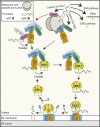Capture and delivery of tail-anchored proteins to the endoplasmic reticulum
- PMID: 34264263
- PMCID: PMC8287540
- DOI: 10.1083/jcb.202105004
Capture and delivery of tail-anchored proteins to the endoplasmic reticulum
Abstract
Tail-anchored (TA) proteins fulfill diverse cellular functions within different organellar membranes. Their characteristic C-terminal transmembrane segment renders TA proteins inherently prone to aggregation and necessitates their posttranslational targeting. The guided entry of TA proteins (GET in yeast)/transmembrane recognition complex (TRC in humans) pathway represents a major route for TA proteins to the endoplasmic reticulum (ER). Here, we review important new insights into the capture of nascent TA proteins at the ribosome by the GET pathway pretargeting complex and the mechanism of their delivery into the ER membrane by the GET receptor insertase. Interestingly, several alternative routes by which TA proteins can be targeted to the ER have emerged, raising intriguing questions about how selectivity is achieved during TA protein capture. Furthermore, mistargeting of TA proteins is a fundamental cellular problem, and we discuss the recently discovered quality control machineries in the ER and outer mitochondrial membrane for displacing mislocalized TA proteins.
© 2021 Farkas and Bohnsack.
Figures




Similar articles
-
Cryo-EM insights into tail-anchored membrane protein biogenesis in eukaryotes.Curr Opin Struct Biol. 2022 Aug;75:102428. doi: 10.1016/j.sbi.2022.102428. Epub 2022 Jul 16. Curr Opin Struct Biol. 2022. PMID: 35850079 Review.
-
A ribosome-associating factor chaperones tail-anchored membrane proteins.Nature. 2010 Aug 26;466(7310):1120-4. doi: 10.1038/nature09296. Epub 2010 Aug 1. Nature. 2010. PMID: 20676083 Free PMC article.
-
The GET pathway can increase the risk of mitochondrial outer membrane proteins to be mistargeted to the ER.J Cell Sci. 2018 May 16;131(10):jcs211110. doi: 10.1242/jcs.211110. J Cell Sci. 2018. PMID: 29661846
-
Ribosome-bound Get4/5 facilitates the capture of tail-anchored proteins by Sgt2 in yeast.Nat Commun. 2021 Feb 4;12(1):782. doi: 10.1038/s41467-021-20981-3. Nat Commun. 2021. PMID: 33542241 Free PMC article.
-
Quality control pathways of tail-anchored proteins.Biochim Biophys Acta Mol Cell Res. 2021 Feb;1868(2):118922. doi: 10.1016/j.bbamcr.2020.118922. Epub 2020 Dec 4. Biochim Biophys Acta Mol Cell Res. 2021. PMID: 33285177 Review.
Cited by
-
Identifying novel genes for amyotrophic lateral sclerosis by integrating human brain proteomes with genome-wide association data.J Neurol. 2023 Aug;270(8):4013-4023. doi: 10.1007/s00415-023-11757-4. Epub 2023 May 6. J Neurol. 2023. PMID: 37148340
-
Mitochondrial antiviral-signalling protein is a client of the BAG6 protein quality control complex.J Cell Sci. 2022 May 1;135(9):jcs259596. doi: 10.1242/jcs.259596. Epub 2022 May 11. J Cell Sci. 2022. PMID: 35543156 Free PMC article.
-
Endogenous Bok is stable at the endoplasmic reticulum membrane and does not mediate proteasome inhibitor-induced apoptosis.Front Cell Dev Biol. 2022 Dec 19;10:1094302. doi: 10.3389/fcell.2022.1094302. eCollection 2022. Front Cell Dev Biol. 2022. PMID: 36601536 Free PMC article.
-
The GET insertase exhibits conformational plasticity and induces membrane thinning.Nat Commun. 2023 Nov 14;14(1):7355. doi: 10.1038/s41467-023-42867-2. Nat Commun. 2023. PMID: 37963916 Free PMC article.
-
Protein Tyrosine Phosphatases: Mighty oaks from little acorns grow.IUBMB Life. 2023 Apr;75(4):337-352. doi: 10.1002/iub.2716. IUBMB Life. 2023. PMID: 36971473 Free PMC article.
References
-
- Asseck, L.Y., Mehlhorn D.G., Monroy J.R., Ricardi M.M., Breuninger H., Wallmeroth N., Berendzen K.W., Nowrousian M., Xing S., Schwappach B., et al. . 2021. Endoplasmic reticulum membrane receptors of the GET pathway are conserved throughout eukaryotes. Proc. Natl. Acad. Sci. USA. 118:e2017636118. 10.1073/pnas.2017636118 - DOI - PMC - PubMed
Publication types
MeSH terms
Substances
LinkOut - more resources
Full Text Sources
Molecular Biology Databases

